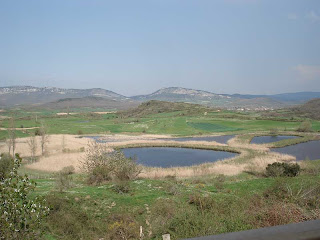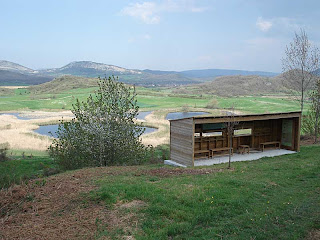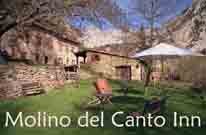 Again I have been able to make a new one square for the Atlas of wintering birds, the VN2050 and again I have been able to enjoy a day of birdwatching, without a doubt this type of bird works becomes an incentive to follow with the birding.
Again I have been able to make a new one square for the Atlas of wintering birds, the VN2050 and again I have been able to enjoy a day of birdwatching, without a doubt this type of bird works becomes an incentive to follow with the birding.This routes into squares is located under the reservoir of the river Ebro, these have a influence in the presence of birds in to the square.

It is a cattle zone and is characterized by the abundance of pastures, and is in these zones where more diversity of birds we can found.
In winter flocks of birds, they move by all the area.


Also wooded areas exist, mainly composed by Oak and Beech trees, in this type of forests the tits, treecrepers, woodpeckers… are the easy ones to find. Although today I did not have luck, is not difficult to see Black Woodpecker.

 List of species recorder in the routes:
List of species recorder in the routes:
1. Northern Lapwing, Vanellus vanellus , two flocks in the pastures 2. Common Snipe, Gallinago gallinago , two birds in a water area in the pastures 3. European Golden Plover, Pluvialis apricaria 4. Great White Egret, Egretta alba , two birds on the pasture area 5. Grey Heron, Ardea cinerea 6. Mallard, Anas platyrhynchos 7. Great Crested Grebe, Podiceps cristatus 8. Common Kestrel, Falco tinnunculus 9. Common Buzzard, Buteo buteo 10. Red-billed Chough, Pyrrhocorax pyrrhocorax 11. Eurasian Jay, Garrulus glandarius 12. Carrion Crow, Corvus corone 13. Common Raven, Corvus corax 14. Magpie, Pica pica 15. Cirl Bunting, Emberiza cirlus 16. Yellowhammer, Emberiza citrinella 17. Rock Bunting, Emberiza cia 18. Sky Lark, Alauda arvensis 19. Common Starling, Sturnus vulgaris 20. Spotless Starling, Sturnus unicolor 21. Dunnock Prunella modularis 22. Meadow Pipit, Anthus pratensis 23. White wagtail, Motacilla alba 24. Robin, Erithacus rubecula 25. Blackbird, Turdus merula 26. Song Thrush, Turdus philomelos 27. Fieldfare, Turdus pilaris 28. Redwing, Turdus iliacus 29. Mistle Thrush Turdus viscivorus 30. Firecrest, Regulus ignicapilla 31. Short-toed Treecreeper, Certhya brachydactyla 32. European Nuthatch, Sitta europaea 33. Green Woodpecker, Picus viridis 34. Long-tailed Tit, Aegithalos caudatus 35. Great Tit, Parus major 36. Blue Tit, Parus caeruleus 37. Common Chaffinch, Fringilla coelebs 38. Brambling, Fringilla montifringilla , flock with 30 birds near of the village of Santa Gadea 39. Goldfinch, Carduelis carduelis 40. Common Bullfinch, Pyrrhula pyrrhula 41. Zitting Cisticola, Cisticola juncidis, four birds near of the river 42. House Sparrow, Paser domesticus 43. Greylag Goose, Anser anser, 18 birds flying towards the south 44. Common Crane, Grus grus 2 birds flying towards the south.




































 As we can see this is a hole of a nest Great Spotted Woopecker (Dendropocos major).
As we can see this is a hole of a nest Great Spotted Woopecker (Dendropocos major). Here we can see since the reform has been made, reducing with mud the inlet diameter of the hole, until obtaining the suitable one.
Here we can see since the reform has been made, reducing with mud the inlet diameter of the hole, until obtaining the suitable one. Here we have the authors of this peculiar adaptation, the Nuthatch (Sitta europaea).
Here we have the authors of this peculiar adaptation, the Nuthatch (Sitta europaea).




 Garganey
Garganey
 Whinchat
Whinchat




















